2015 FIAT 500L LIVING ESP
[x] Cancel search: ESPPage 4 of 224
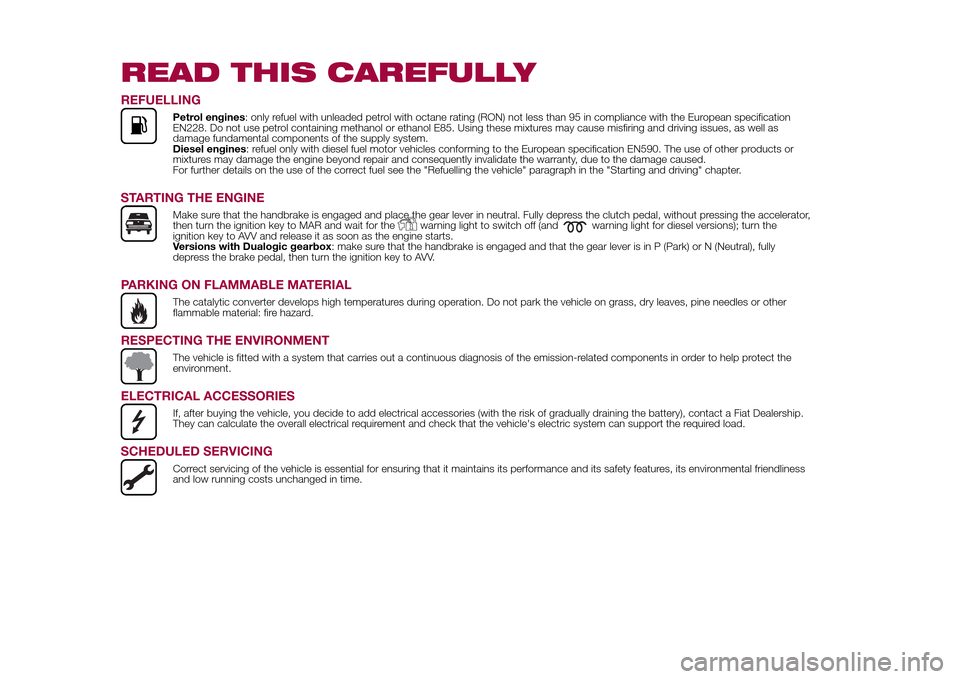
READ THIS CAREFULLYREFUELLING
Petrol engines: only refuel with unleaded petrol with octane rating (RON) not less than 95 in compliance with the European specification
EN228. Do not use petrol containing methanol or ethanol E85. Using these mixtures may cause misfiring and driving issues, as well as
damage fundamental components of the supply system.
Diesel engines: refuel only with diesel fuel motor vehicles conforming to the European specification EN590. The use of other products or
mixtures may damage the engine beyond repair and consequently invalidate the warranty, due to the damage caused.
For further details on the use of the correct fuel see the "Refuelling the vehicle" paragraph in the "Starting and driving" chapter.
STARTING THE ENGINE
Make sure that the handbrake is engaged and place the gear lever in neutral. Fully depress the clutch pedal, without pressing the accelerator,
then turn the ignition key to MAR and wait for the
warning light to switch off (and
warning light for diesel versions); turn the
ignition key to AVV and release it as soon as the engine starts.
Versions with Dualogic gearbox: make sure that the handbrake is engaged and that the gear lever is in P (Park) or N (Neutral), fully
depress the brake pedal, then turn the ignition key to AVV.
PARKING ON FLAMMABLE MATERIAL
The catalytic converter develops high temperatures during operation. Do not park the vehicle on grass, dry leaves, pine needles or other
flammable material: fire hazard.
RESPECTING THE ENVIRONMENT
The vehicle is fitted with a system that carries out a continuous diagnosis of the emission-related components in order to help protect the
environment.
ELECTRICAL ACCESSORIES
If, after buying the vehicle, you decide to add electrical accessories (with the risk of gradually draining the battery), contact a Fiat Dealership.
They can calculate the overall electrical requirement and check that the vehicle's electric system can support the required load.
SCHEDULED SERVICING
Correct servicing of the vehicle is essential for ensuring that it maintains its performance and its safety features, its environmental friendliness
and low running costs unchanged in time.
9-1-2015 12:9 Pagina 2
Page 5 of 224
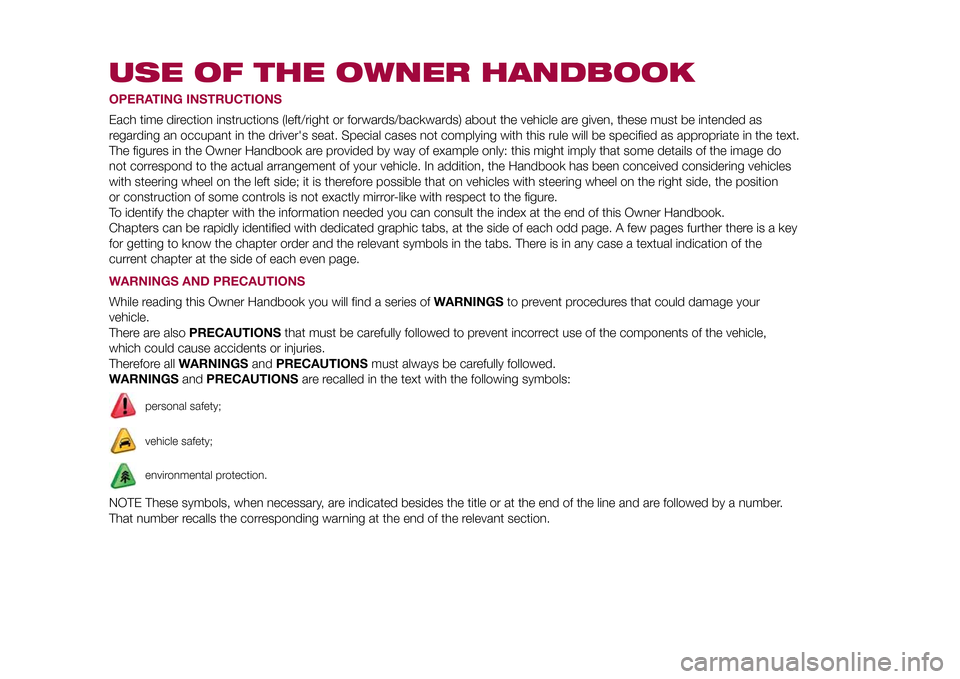
USE OF THE OWNER HANDBOOKOPERATING INSTRUCTIONSEach time direction instructions (left/right or forwards/backwards) about the vehicle are given, these must be intended as
regarding an occupant in the driver's seat. Special cases not complying with this rule will be specified as appropriate in the text.
The figures in the Owner Handbook are provided by way of example only: this might imply that some details of the image do
not correspond to the actual arrangement of your vehicle. In addition, the Handbook has been conceived considering vehicles
with steering wheel on the left side; it is therefore possible that on vehicles with steering wheel on the right side, the position
or construction of some controls is not exactly mirror-like with respect to the figure.
To identify the chapter with the information needed you can consult the index at the end of this Owner Handbook.
Chapters can be rapidly identified with dedicated graphic tabs, at the side of each odd page. A few pages further there is a key
for getting to know the chapter order and the relevant symbols in the tabs. There is in any case a textual indication of the
current chapter at the side of each even page.WARNINGS AND PRECAUTIONSWhile reading this Owner Handbook you will find a series ofWARNINGSto prevent procedures that could damage your
vehicle.
There are alsoPRECAUTIONSthat must be carefully followed to prevent incorrect use of the components of the vehicle,
which could cause accidents or injuries.
Therefore allWARNINGSandPRECAUTIONSmust always be carefully followed.
WARNINGSandPRECAUTIONSare recalled in the text with the following symbols:
personal safety;vehicle safety;environmental protection.
NOTE These symbols, when necessary, are indicated besides the title or at the end of the line and are followed by a number.
That number recalls the corresponding warning at the end of the relevant section.
9-1-2015 12:9 Pagina 3
Page 11 of 224
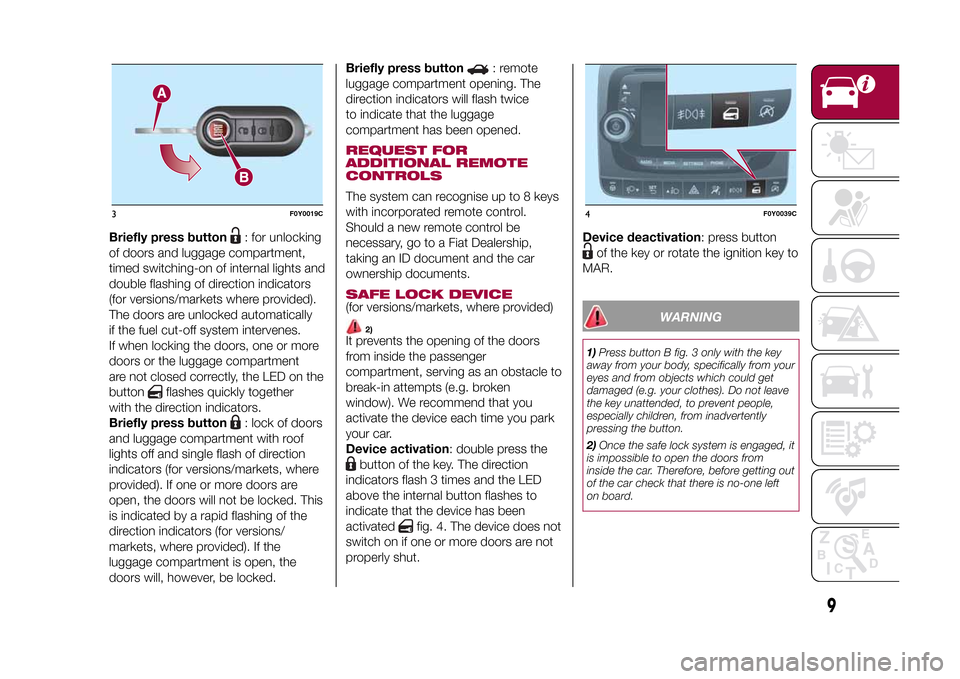
Briefly press button
: for unlocking
of doors and luggage compartment,
timed switching-on of internal lights and
double flashing of direction indicators
(for versions/markets where provided).
The doors are unlocked automatically
if the fuel cut-off system intervenes.
If when locking the doors, one or more
doors or the luggage compartment
are not closed correctly, the LED on the
button
flashes quickly together
with the direction indicators.
Briefly press button
: lock of doors
and luggage compartment with roof
lights off and single flash of direction
indicators (for versions/markets, where
provided). If one or more doors are
open, the doors will not be locked. This
is indicated by a rapid flashing of the
direction indicators (for versions/
markets, where provided). If the
luggage compartment is open, the
doors will, however, be locked.Briefly press button
: remote
luggage compartment opening. The
direction indicators will flash twice
to indicate that the luggage
compartment has been opened.
REQUEST FOR
ADDITIONAL REMOTE
CONTROLSThe system can recognise up to 8 keys
with incorporated remote control.
Should a new remote control be
necessary, go to a Fiat Dealership,
taking an ID document and the car
ownership documents.SAFE LOCK DEVICE(for versions/markets, where provided)
2)
It prevents the opening of the doors
from inside the passenger
compartment, serving as an obstacle to
break-in attempts (e.g. broken
window). We recommend that you
activate the device each time you park
your car.
Device activation: double press the
button of the key. The direction
indicators flash 3 times and the LED
above the internal button flashes to
indicate that the device has been
activated
fig. 4. The device does not
switch on if one or more doors are not
properly shut.Device deactivation: press button
of the key or rotate the ignition key to
MAR.
WARNING
1)Press button B fig. 3 only with the key
away from your body, specifically from your
eyes and from objects which could get
damaged (e.g. your clothes). Do not leave
the key unattended, to prevent people,
especially children, from inadvertently
pressing the button.
2)Once the safe lock system is engaged, it
is impossible to open the doors from
inside the car. Therefore, before getting out
of the car check that there is no-one left
on board.
3
F0Y0019C
4
F0Y0039C
9
9-1-2015 12:9 Pagina 9
Page 28 of 224
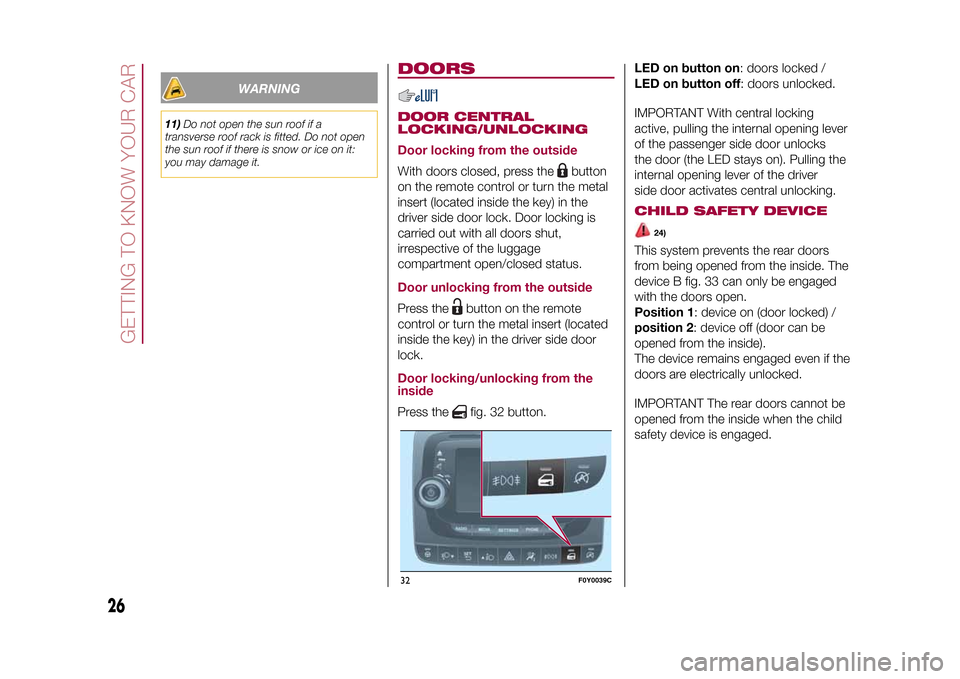
WARNING
11)Do not open the sun roof if a
transverse roof rack is fitted. Do not open
the sun roof if there is snow or ice on it:
you may damage it.
DOORSDOOR CENTRAL
LOCKING/UNLOCKING
Door locking from the outsideWith doors closed, press the
button
on the remote control or turn the metal
insert (located inside the key) in the
driver side door lock. Door locking is
carried out with all doors shut,
irrespective of the luggage
compartment open/closed status.
Door unlocking from the outsidePress the
button on the remote
control or turn the metal insert (located
inside the key) in the driver side door
lock.
Door locking/unlocking from the
insidePress the
fig. 32 button.LED on button on: doors locked /
LED on button off: doors unlocked.
IMPORTANT With central locking
active, pulling the internal opening lever
of the passenger side door unlocks
the door (the LED stays on). Pulling the
internal opening lever of the driver
side door activates central unlocking.
CHILD SAFETY DEVICE
24)
This system prevents the rear doors
from being opened from the inside. The
device B fig. 33 can only be engaged
with the doors open.
Position 1: device on (door locked) /
position 2: device off (door can be
opened from the inside).
The device remains engaged even if the
doors are electrically unlocked.
IMPORTANT The rear doors cannot be
opened from the inside when the child
safety device is engaged.
32
F0Y0039C
26
GETTING TO KNOW YOUR CAR
9-1-2015 12:9 Pagina 26
Page 35 of 224

IMPORTANT The Dualdrive electric
power steering has an electronic
damping effect while approaching the
end of stroke. In some manoeuvring
conditions, the steering wheel might
rotate a bit before touching its
mechanical stop. This behaviour is
standard as it takes place to prevent
strong impacts on the mechanical
components inside the device.POWER STEERING
ACTIVATION/
DEACTIVATION
33) 34)
Activation/deactivation: press the fig.
46 button.
The activation of the function is
signalled by the switching on of the
LED located on the button and by the
displaying of the word CITY on the
instrument panel or, depending on the
version, on the display.When the power steering is on, the
steering wheel effort is lighter, making
parking easier: therefore, this function is
particularly useful for driving in city
centres.
WARNING
33)It is absolutely forbidden to carry out
any after-market operation involving
steering system or steering column
modifications (e.g. installation of anti-theft
device) that could adversely affect
performance and safety, invalidate the
warranty and also result in non-compliance
of the vehicle with type-approval
requirements.
34)Before performing any maintenance
operations, always turn off the engine and
remove the key from the ignition to lock the
steering column (especially when the car
wheels are not touching the ground). If this
is not possible (for example if the key
needs to be turned to MAR or the engine
must be running), remove the main fuse
that protects the electric power steering.
VERSION WITH LPG
SYSTEM
35) 36) 37)16) 17) 18) 19) 20) 21) 22)
INTRODUCTIONThe LPG version features two fuel
supply systems: one for petrol and one
for LPG.PASSIVE SAFETY/ACTIVE
SAFETYAlthough the LPG system has
numerous safety features, it is advisable
to proceed as follows every time the
vehicle is not in use for a long period or
moved in an emergency as a result of
a breakdown or accident:
❒unscrew the fixing devices A fig. 47,
then remove the cover B;
❒close the LPG cock by rotating the
ring nut C fig. 48 clockwise;
❒refit the cover and retighten the
fastening devices.
46
F0Y0420C
33
9-1-2015 12:9 Pagina 33
Page 42 of 224
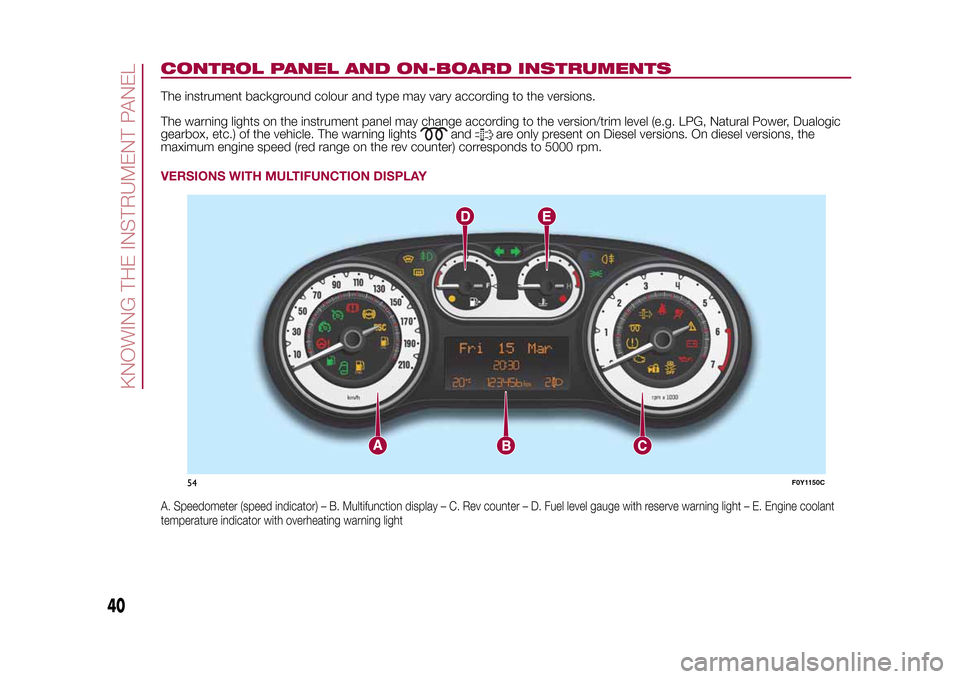
CONTROL PANEL AND ON-BOARD INSTRUMENTSThe instrument background colour and type may vary according to the versions.
The warning lights on the instrument panel may change according to the version/trim level (e.g. LPG, Natural Power, Dualogic
gearbox, etc.) of the vehicle. The warning lights
and
are only present on Diesel versions. On diesel versions, the
maximum engine speed (red range on the rev counter) corresponds to 5000 rpm.
VERSIONS WITH MULTIFUNCTION DISPLAYA. Speedometer (speed indicator) – B. Multifunction display – C. Rev counter – D. Fuel level gauge with reserve warning light – E. Engine coolant
temperature indicator with overheating warning light
54
F0Y1150C
40
KNOWING THE INSTRUMENT PANEL
9-1-2015 12:9 Pagina 40
Page 67 of 224
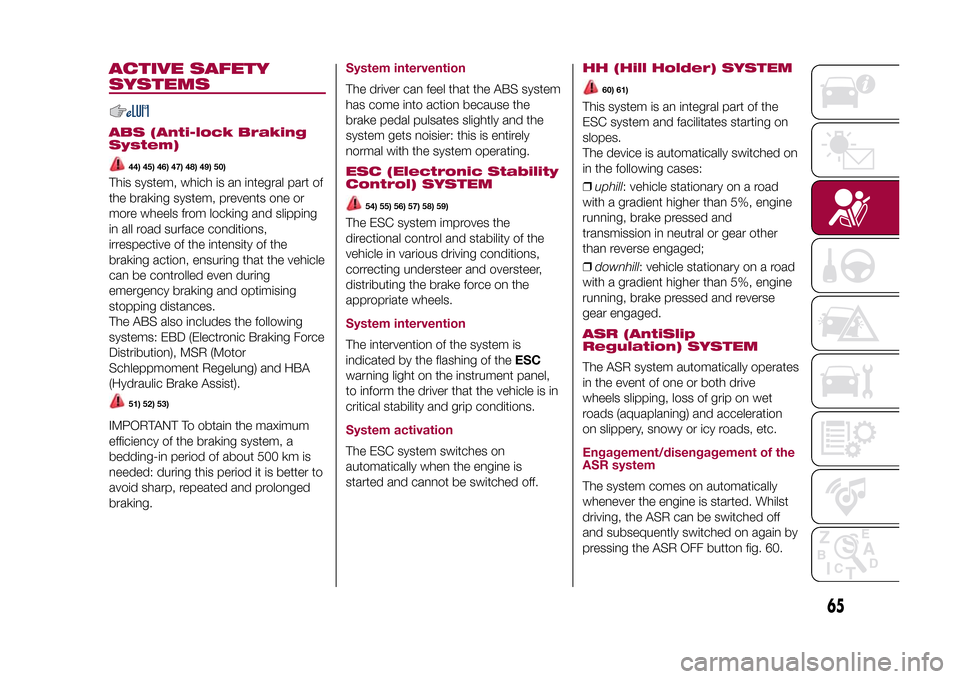
ACTIVE SAFETY
SYSTEMSABS (Anti-lock Braking
System)
44) 45) 46) 47) 48) 49) 50)
This system, which is an integral part of
the braking system, prevents one or
more wheels from locking and slipping
in all road surface conditions,
irrespective of the intensity of the
braking action, ensuring that the vehicle
can be controlled even during
emergency braking and optimising
stopping distances.
The ABS also includes the following
systems: EBD (Electronic Braking Force
Distribution), MSR (Motor
Schleppmoment Regelung) and HBA
(Hydraulic Brake Assist).
51) 52) 53)
IMPORTANT To obtain the maximum
efficiency of the braking system, a
bedding-in period of about 500 km is
needed: during this period it is better to
avoid sharp, repeated and prolonged
braking.
System interventionThe driver can feel that the ABS system
has come into action because the
brake pedal pulsates slightly and the
system gets noisier: this is entirely
normal with the system operating.ESC (Electronic Stability
Control) SYSTEM
54) 55) 56) 57) 58) 59)
The ESC system improves the
directional control and stability of the
vehicle in various driving conditions,
correcting understeer and oversteer,
distributing the brake force on the
appropriate wheels.System interventionThe intervention of the system is
indicated by the flashing of theESC
warning light on the instrument panel,
to inform the driver that the vehicle is in
critical stability and grip conditions.System activationThe ESC system switches on
automatically when the engine is
started and cannot be switched off.
HH (Hill Holder) SYSTEM
60) 61)
This system is an integral part of the
ESC system and facilitates starting on
slopes.
The device is automatically switched on
in the following cases:
❒uphill: vehicle stationary on a road
with a gradient higher than 5%, engine
running, brake pressed and
transmission in neutral or gear other
than reverse engaged;
❒downhill: vehicle stationary on a road
with a gradient higher than 5%, engine
running, brake pressed and reverse
gear engaged.ASR (AntiSlip
Regulation) SYSTEMThe ASR system automatically operates
in the event of one or both drive
wheels slipping, loss of grip on wet
roads (aquaplaning) and acceleration
on slippery, snowy or icy roads, etc.Engagement/disengagement of the
ASR systemThe system comes on automatically
whenever the engine is started. Whilst
driving, the ASR can be switched off
and subsequently switched on again by
pressing the ASR OFF button fig. 60.
65
9-1-2015 12:9 Pagina 65
Page 68 of 224
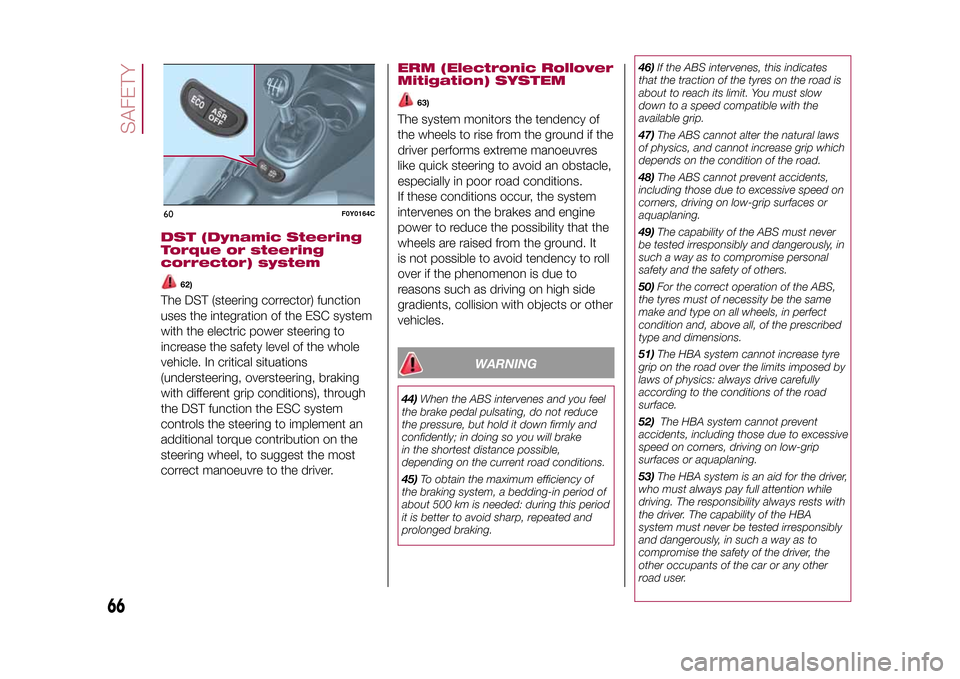
DST (Dynamic Steering
Torque or steering
corrector) system
62)
The DST (steering corrector) function
uses the integration of the ESC system
with the electric power steering to
increase the safety level of the whole
vehicle. In critical situations
(understeering, oversteering, braking
with different grip conditions), through
the DST function the ESC system
controls the steering to implement an
additional torque contribution on the
steering wheel, to suggest the most
correct manoeuvre to the driver.
ERM (Electronic Rollover
Mitigation) SYSTEM
63)
The system monitors the tendency of
the wheels to rise from the ground if the
driver performs extreme manoeuvres
like quick steering to avoid an obstacle,
especially in poor road conditions.
If these conditions occur, the system
intervenes on the brakes and engine
power to reduce the possibility that the
wheels are raised from the ground. It
is not possible to avoid tendency to roll
over if the phenomenon is due to
reasons such as driving on high side
gradients, collision with objects or other
vehicles.
WARNING
44)When the ABS intervenes and you feel
the brake pedal pulsating, do not reduce
the pressure, but hold it down firmly and
confidently; in doing so you will brake
in the shortest distance possible,
depending on the current road conditions.
45)To obtain the maximum efficiency of
the braking system, a bedding-in period of
about 500 km is needed: during this period
it is better to avoid sharp, repeated and
prolonged braking.46)If the ABS intervenes, this indicates
that the traction of the tyres on the road is
about to reach its limit. You must slow
down to a speed compatible with the
available grip.
47)The ABS cannot alter the natural laws
of physics, and cannot increase grip which
depends on the condition of the road.
48)The ABS cannot prevent accidents,
including those due to excessive speed on
corners, driving on low-grip surfaces or
aquaplaning.
49)The capability of the ABS must never
be tested irresponsibly and dangerously, in
such a way as to compromise personal
safety and the safety of others.
50)For the correct operation of the ABS,
the tyres must of necessity be the same
make and type on all wheels, in perfect
condition and, above all, of the prescribed
type and dimensions.
51)The HBA system cannot increase tyre
grip on the road over the limits imposed by
laws of physics: always drive carefully
according to the conditions of the road
surface.
52)The HBA system cannot prevent
accidents, including those due to excessive
speed on corners, driving on low-grip
surfaces or aquaplaning.
53)The HBA system is an aid for the driver,
who must always pay full attention while
driving. The responsibility always rests with
the driver. The capability of the HBA
system must never be tested irresponsibly
and dangerously, in such a way as to
compromise the safety of the driver, the
other occupants of the car or any other
road user.
60
F0Y0164C
66
SAFETY
9-1-2015 12:9 Pagina 66